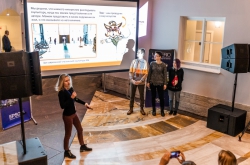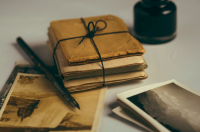About Yuri Molodkovets
I've been working at the Hermitage for more than 25 years, and I spent 20 of them in the Editorial and Publishing Department. Museum photography is a very serious business. The main task of a museum photographer is to take pictures of objects in the museum's collections in such a way that they would show their true beauty. Why is that so important? The truth is that the Hermitage has over 3 million exhibits in storage, and, only 5-7% of them are on permanent display.
Temporary exhibitions are sometimes the only opportunity to see some of these items. A museum photographer’s goal is to take photos of these objects that would communicate their authors’ mastery and the beauty of their materials. Afterwards, these photographs are included in catalogs that we make for almost every exhibition.

I've also been involved with different multimedia projects. For instance, five years ago I proposed that we start working in the field of museum art photography. Nowadays, I guide a tour called "The history and art of photography in a museum environment", in which I show how the Old Masters used the techniques that are now applied in photography.
The Hermitage Instagram
Another such project is the Hermitage Instagram page that we launched in 2014. The story behind it is quite simple: when Instagram first appeared, I signed up for it and found it to be a great instrument for everyone who works with images and truly feels them.
What does "feeling an image" mean? In essence, photography is a universal language which we can use to communicate with each other. Any picture has a story to tell, the question here has to do with the quality of this communication. When having a conversation, some of us use everyday language, some use literary language, and there are even those who can speak in poetry. Photography is pretty much the same: an image with a deeper meaning is easier to remember and evokes a stronger response. If you can speak in the language of photography, your images are truly eye-catching, and the viewers understand the message you put into them.

It didn’t take long before I suggested that we create an Instagram account for the Hermitage. For restoration artists, museums are mostly about preservation of art, art experts associate them with research, but common visitors come here to look at art itself, so it is only logical that the museum would offer yet another opportunity to do that. Giving new knowledge is also among museums’ important functions. In this sense, the Hermitage is not just a collection of masterpieces, but also a whole encyclopedia that contains information about the world's different cultures.
Top content
I see the Hermitage's Instagram account as some kind of living history: I know the museum, I look at the people who go there, and I also come up with some ideas of my own. During these several years, I've developed a few algorithms, some of which were quite successful.
User-made content
At one point I became interested in how exactly people choose to spend their time at the Hermitage. I started searching for particular hashtags in order to find the visitors' photos of the museum, choosing the most interesting ones and reposting them. This category has existed for quite a long time. First of all, it got a great response from those who shot the photos: obviously, they were flattered that a major museum noticed their work. What's more, it also resonated with a wide audience.

Experimenting with format
Some time later, I decided that it would be interesting to shoot fragments of the museum’s interiors. The Hermitage occupies several buildings, some of which weren't designed for being a museum. Their initial function was different, and today many exhibits are displayed in beautifully decorated rooms. Such details are also very interesting, so this format got quite popular. I've also applied this approach to the museum's masterpieces: I don't just show them in full, but the fragments, as well. Highlighting particular parts of a masterpiece can also be very important.
News and events
By all means, I sometimes post images related to the museum's news. Still, I don't like the idea of turning an Instagram account into some news outlet. Though there are numerous events going on at the Hermitage, not all of them can be of interest to a wide audience. Also, if I were to post about everything that's happening at the museum, it would be too similar to spamming. Even when my audience was small, I noticed that they don't really like it when you have lots of publications every day: posting once is good, posting twice or thrice is OK, but when you do more, you start losing subscribers. So I limit myself to three publications a day, but do it every day, holidays and vacations included.

“Children in the museum”
I started this series because I have a son myself. When he was little, we often went to museums. I photographed him a lot while we were doing that. Posts with children always get a huge response and lots of comments. On the whole, those come in two categories. Some say: "Why take children to a museum? They make lots of noise, and I doubt that they really want to". Others argue: "Why? Where else should you take them?". I never participate in these discussions, as it would take too much time. Also, I believe that it has to be the Director or some authorized representative who shall speak on the Hermitage's behalf. Still, I surely have my personal opinion on this matter. I believe that going to museums is a must at any age.
"Sun in the museum"
This one is very popular, and some say that it has become the calling card of the Hermitage's Instagram. As you may know, excess sunlight is not very good for a museum, as it can damage the exhibits. On the other hand, the architects who designed the Hermitage sought to make the most of natural lighting, and its interiors look stunning in sunlight. That’s why I try to capture such images whenever I get the chance.

Resolving conflicts
As you might remember, two years ago we hosted the Jan Fabre exhibition "Knight of Despair / Warrior of Beauty". This was a highly charged exhibition that should have had a great effect on many viewers by helping them reinterpret what's commonly displayed at the Hermitage. And it all ended up in a scandal that stemmed from social networks, namely Instagram. Lots of posts against the Hermitage and Fabre emerged, about us having supposedly tortured animals and so on. What's more, many of them were obviously fake, written in a similar manner and featuring the same images; some were even posted by business accounts.
As a result, we decided to call a meeting in order to come up with a solution. For instance, we launched the #котикизафабра ("#kittensforFabre) hashtag that was associated with the famous Hermitage cats. Everything came to an end in just two days. In the end, our cats protected not just the museum, but Fabre as well.

Instagram Live: pros and cons
I don't really like live broadcasts, and I rarely watch them. Most of them are just boring, and the quality of video and sound is often terrible. Still, this format is unexpectedly popular, as we once learned from our own experience. At one of our meetings where we discussed live broadcasts, I suggested we start one right on the spot, took out my smartphone and started streaming. In only 30 seconds, we got over 500 viewers. We were really surprised, as we didn't think of what we were doing as something interesting. Even now, I find the popularity of live broadcasts strange, but if you have good content, you just have to use it.
Smartphones vs cameras
I think that about 95% of all photos that appear on the Hermitage's Instagram are made with smartphones. But we also post photos from our archives. What is more, if I know that a photo of some particular subject has already been made with a camera, I will surely choose to post it. For example, we had this project called "Hermitage at Night": I went to the museum at night with a tripod and other tools, and used long exposure and other techniques. Those photos can’t be replicated easily. I post those photos a lot, as you just can't make something this good while using a smartphone.

Offline projects
Apart from everything that exists on social media, I am always interested in things from real life. In this regard, I like it when projects are exhibited in strange places. Some time ago, I did an exhibition dedicated to the Hermitage's Instagram in Mikhailovsky Theatre. We printed our pictures on 1x1 meter sheets, and they turned out to be very good. Still, only those who went to the Mikhailovsky Theater who could see them, so we decided to develop this initiative further. One of our partners made a deal with a shopping center, and we've displayed our photos there.
Promotion
We never used any like-farming techniques to increase our Instagram engagement. We have over 255,000 subscribers, which makes us the most popular museum account in Russia, though it's nothing much in comparison with celebrity accounts. We sometimes work with bloggers: once, we organized tours of the Hermitage for them. At the moment, this project is over, as we've walked through all of our buildings, but we're ready to consider new initiatives.

Instagram and the future of photography
First photographs were made with cumbersome devices, then snapshot cameras were invented. It was already then that everyone thought that photography was at the peak of its development. Even so, after the introduction of digital photography, it became apparent that photography has a long way ahead. Now that we can make photos with our smartphones, it seems that it has truly conquered the world.
Surely, there are all kinds of different equipment, but the best camera is something that you always have on you. Even if you own some top-notch device with a bunch of lenses and lots of other equipment, but keep it somewhere on a shelf, you just won't get your chance to create a masterpiece. The fact that they will keep on getting smaller and smaller must surely mean that, at some point, we’ll finally become fully inseparable from our cameras.




